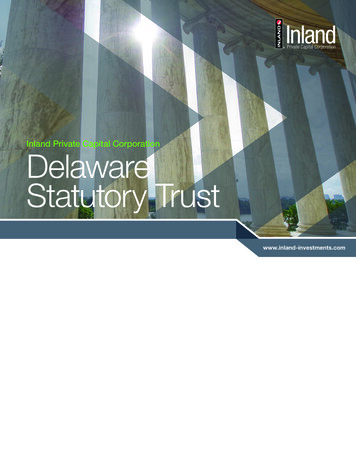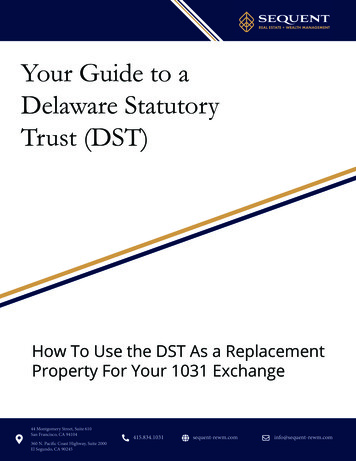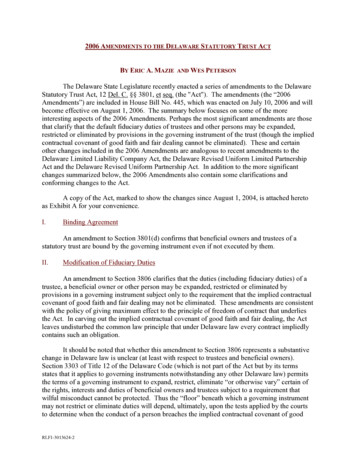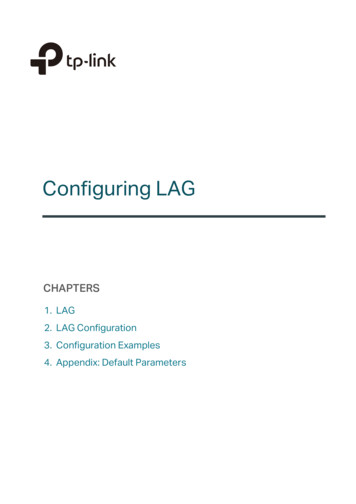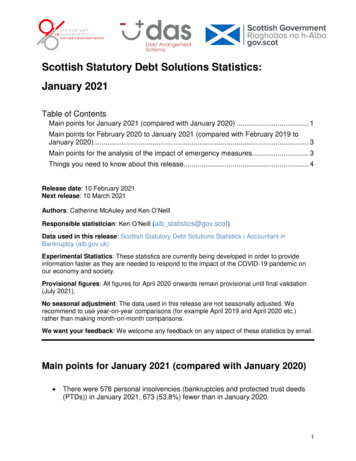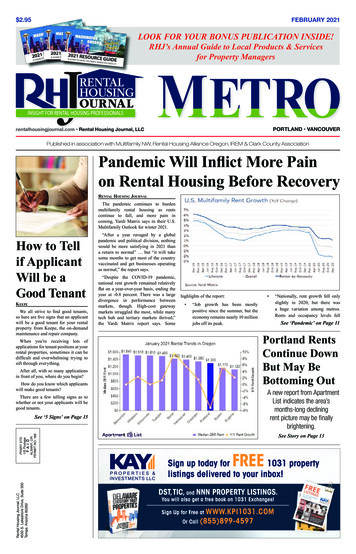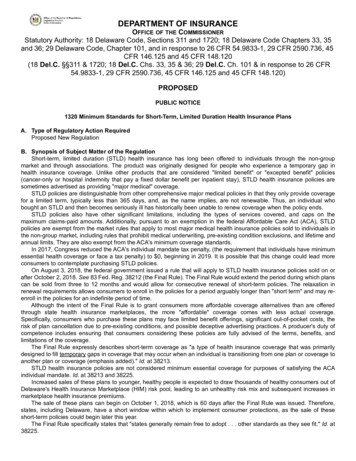
Transcription
Delaware Statutory Trust (DST) Properties –An Introduction to DST Properties for1031 Exchange InvestorsBy: Dwight Kay,Founder and CEO of Kay Properties and Investments, LLC
This publication is protected under the US Copyright Act of 1976 and all other applicableinternational, federal, state and local laws, and all rights are reserved, including resalerights. If you received this publication from anyone other than Kay Properties andInvestments, LLC, you’ve received a pirated copy.No part of this document or the related files may be reproduced or transmitted in anyform, by any means (electronic, photocopying, recording, or otherwise) without the priorwritten permission of the publisher.Limit of Liability and Disclaimer of Warranty: The publisher has used its best efforts inpreparing this book, and the information provided herein is provided “as is.” KayProperties and Investments, LLC and Dwight Kay make no representation or warrantieswith respect to the accuracy or completeness of the contents of this book and specificallydisclaims any implied warranties of merchantability or fitness for any particular purposeand shall in no event be liable for any loss of profit or any other commercial damage,including but not limited to special, incidental, consequential, or other damages.Copyright 2015 Kay Properties and Investments, LLC and Dwight Kay.All rights reserved.
This book is dedicated to my little brother,Jesse John Payne Kay.Thanks for believing in me, I love you and I can’t wait to see you in the blinkof an eye
Foreword:Thank you very much for purchasing this book on 1031 exchange DelawareStatutory Trust (DST 1031) properties. This book is meant to serve as anintroduction for you the reader to DST 1031 properties as you begin toexplore if they are the right fit for your upcoming 1031 exchange.I decided to write this book because there is no other published volumeavailable to 1031 exchange investors on DST properties that I am aware of. Ibelieve that education has been one of the reasons for the growth of mycompany, Kay Properties and Investments LLC, over the years and I hopethat you enjoy learning more about this subject matter in an easy-to-read, asnon-technical as possible format.I also invite you to receive a wealth of additional information on DST 1031properties for free by registering at my website kpi1031.com. You willreceive access to a large amount of valuable content, such as a currentlyavailable DST 1031 property menu, white papers, infographics andeducational videos.Lastly, if you have further questions and want more in-depth details on youroptions with DST 1031 properties, feel free to email me atdwightkay@kpi1031.com.I hope you enjoy this book!Best Regards,-- Dwight KayLooking for more insight on DST properties? Attend one of our freeupcoming educational conference calls by registering atkpi1031.com/register.
Table of ContentsChapter 1: DST 1031 Properties – The BasicsChapter 2: What Are the Potential Benefits of Exchanginginto a DST Property?Chapter 3: What Are the Risks of DST 1031 Properties?Chapter 4: Illiquidity and Exit StrategiesChapter 5: Who Is Who - The Roles of DST IndustryPlayersChapter 6: Why Do 1031 Investors Choose DST PropertiesOver Traditional NNN Properties?Chapter 7: The Section 721 ExchangeChapter 8: The DST as a Cash Investment VehicleChapter 9: Kay Properties and Investments - A DSTBrokerage and Advisory FirmAppendix A: Client TestimonialsAppendix B: Press ReleasesAppendix C: Educational Video Media library
Risks and Disclosures:This book is not intended to be an exhaustive document and contains generalinformation on DST 1031 properties. This information, including thenumbers, statistics and examples herein, is general in nature, approximateand intended for educational purposes only.Please remember that this book is not intended to provide any tax or legaladvice to you. We highly encourage all readers of this book to speak withtheir CPA and attorney prior to considering an investment in a DST 1031property for all tax and legal advice. We also encourage you to speak withyour CPA and attorney to determine if an investment in DST 1031properties may be suitable for your particular circumstances.There are risks associated with investing in DST 1031 properties, including,but not limited to, that you could lose your entire principal amount invested.We have outlined additional risk factors in Chapter 3. We also encourageyou to read each prospective DST 1031 property’s full offering materialsand Private Placement Memorandum (PPM) prior to investing, payingcareful attention to the risk section.
Chapter 1:DST 1031 Properties – The Basics
Chapter 1:DST 1031 Properties – The BasicsA Delaware Statutory Trust (DST) is an entity that is used to hold title toinvestment real estate. In some ways, this is similar to how a LimitedLiability Company (LLC) can hold title to real estate; however, unlike anLLC, a DST 1031 property will qualify as “like kind” exchange replacementproperty for a 1031 exchange. This qualification as “like kind” property ispursuant to the Internal Revenue Code Section 2004-86.The DST entity can be used to hold title to most types of real estate;however, a typical DST 1031 property is a triple net (NNN) leased retail oroffice property or a multifamily apartment community. A NNN leasedproperty is a property whereby the tenant (and not the landlord) is typicallyresponsible for property maintenance costs, insurance premiums andproperty taxes.Other types of DST 1031 properties that have been available to investorshave included shopping centers, government leased buildings, self-storagefacilities, senior living communities, warehouses, distribution facilities,medical office buildings, fast food buildings, pharmacies and grocery stores.Typically, at any given time, Kay Properties has 10 to 15 DST 1031properties available to our qualified accredited clients, with a typicalminimum investment of 100,000.The following are hypothetical examples of DST 1031 properties, and actualproperties, tenants, lease terms and financing structures may vary greatly.Please note that the names listed below are independent of Kay Propertiesand Investments and belong to their respective copyright and trademarkedcompanies. Please also note that there are material risks associated withinvesting in real estate and DST properties, including but not limited to lossof entire principal amount invested. Please review the risk section of theprivate placement memorandum for any potential DST offering that you are
considering, and speak with your CPA and attorney prior to investing. A 300-unit class-A multifamily community located in Austin, Texas.The property is 97 percent occupied and financed with a long-termnon-recourse loan provided by Fannie Mae. A portfolio of four Walgreens throughout the United States that are100 percent occupied on an absolute-NNN lease by Walgreenscorporate. An all-cash, debt-free CVS pharmacy on a corporate-backed, longterm 25-year absolute-NNN lease. A 15-story office building that is 100 percent occupied as theheadquarters of a major Fortune 500 company on a long-term NNNlease. A 100 percent occupied, NNN leased BJ’s Wholesale Club located inthe New York metropolitan area. A 478-unit, class-A self-storage facility located in Dallas, Texas. A portfolio of 12, 100 percent occupied, single tenant, freestandingnet lease properties located throughout the country. Tenants includeCVS, Walgreens, McDonald’s, Tractor Supply Company, Auto Zone,7 Eleven, Dollar General, Kentucky Fried Chicken (KFC), Taco Bell,Applebee’s, Sherwin Williams and KinderCare. A 250-unit, class-B plus multifamily apartment community located inBoston, Massachusetts and 95 percent occupied. Lastly, a medical office building, 100 percent leased to the Universityof California, Los Angeles Health System on a 15-year NNN lease.DST 1031 properties also have various financing ratios to satisfy aninvestor’s exchange requirements of taking on “equal or greater debt,” asdefined by the Internal Revenue Code Section 1031. However, some DST1031 properties are offered all-cash, debt-free in order to mitigate the risk ofusing financing when purchasing real estate.
The financing used on DST 1031 properties is typically non-recourse to theinvestor. Non-recourse financing is typically defined as financing wherebythe lender’s only remedy in the case of a default is the subject property itself.The lender is not able to pursue the investor’s other assets beyond thesubject property. So, investors could lose their entire principal amountinvested in the property in the case of a major tenant bankruptcy, marketwide recession or depression, but their other assets would be protected froma lender.The non-recourse financing used on DST 1031 properties is typically longterm (usually seven to 20 years) and already locked and in place with thelender. This can greatly help to reduce 1031 exchange closing risk forinvestors that must be able to identify a property within their 45-dayidentification period that they know that are going to be able to close on.From our observations at Kay Properties, the typical loan to cost of a DST1031 property ranges between 40-65 percent as of this writing in 2015. ADST 1031 property with a 50 percent loan to cost is a property wherein theinvestors are putting down half of the required equity or cash amount topurchase the DST property and the lender is providing the other half, in theform of a mortgage.As an owner of the DST 1031 property, you will typically receive 100percent of your pro-rata portion of any potential principal pay-down fromthe loan on the property, thereby potentially building equity in the property.It is important to note that some DST 1031 properties are structured withprincipal pay-down beginning the first year, others with principal pay-downbeginning in year two to five and others that are interest-only financing forthe life of the loan.DST 1031 properties are structured whereby the investors in the DSTreceive 100 percent of their pro-rata portion of the potential rental incomegenerated by the property’s tenants. DST investors receive 100 percent oftheir pro-rata portion of any potential net appreciation of the property overthe hold period. This is an area that truly differentiates DST 1031 propertiesfrom partnerships. With a partnership, the offerings sponsor is typicallyentitled to a portion of the potential rental income and potential appreciation.Investors are keenly interested in the fact that when a DST 1031 property is
sold, they are free to do another future 1031 exchange into any type of “likekind” replacement property. Typically, our clients at Kay Properties andInvestments do further 1031 exchanges into more DST 1031 properties;however, you are free to invest in any other type of “like kind” property thatyou choose to upon the sale of your DST property.From our observations at Kay Properties, we see DST 1031 properties, as ofthis writing in 2015, providing a projected cash-on-cash return of between 5and 8 percent. The cash-on-cash return is a metric used in real estate todetermine return on equity and is commonly referred to as cash flow. Thevariation in projected cash flows is due to a number of factors such as assetclass (commercial properties typically provides a higher projected cash flowthan multifamily apartments), location (strong primary markets like NewYork City and San Francisco typically have lower projected cash flows thansmaller secondary or tertiary markets), age of the buildings, years remainingon the primary lease term and strength of the tenant (Are they consideredinvestment-grade by Standard and Poor’s or non-investment grade? Is it apublic or private company? Does the company have a positive growthoutlook or is it a contracting industry?). These are just some of the factorsthat can influence projected cash flows on DST 1031 properties.The projected cash flow on DST 1031 properties is a “net” number to DSTinvestors. This means the projected cash flow is “net” of all managementfees, debt service payments and property expenses. For example, if aninvestor invests 1 million into a DST 1031 property with a projected cashflow of 7 percent, the net amount projected to be sent to the investor thatyear is 70,000. DST 1031 properties’ projected cash flow is typically paidto the DST owners on a monthly basis via either ACH direct deposit straightinto the investors checking or savings accounts or a physical check(whichever the investor prefers).It is important to note that cash flow from real estate and DST 1031properties, as well as past performance, is not guaranteed, as it is a functionof the underlying real estate and tenants and their economic performance.Just as with all other types of real estate, projected cash flows could be lowerthan anticipated. It is very important for you as an investor to believe in theproperty, its location and its tenants before investing, as well as to review therisk factors of the offering materials in their entirety.With DST 1031 properties investors are able to utilize depreciation and
interest write-offs to partially shelter their projected cash flow from taxes.This allows for tax-advantaged potential rental income to the investor. Thisis another reason why many of our clients have invested non-1031 exchangediscretionary funds into DST 1031 properties, which we will look intofurther in Chapter 6.A typical DST 1031 property can be closed on within five business daysafter submitting subscription documents. DST 1031 properties can be closedon this quickly because typically all of the appraisals, environmental reports,property condition reports, financing, tenant estoppels, etc. have alreadybeen completed, as DST 1031 properties are “pre-packaged” for 1031exchange investors. This is one of the reasons why DST 1031 propertieshave become very popular with investors that are in their 45-dayidentification period and close to running the risk of a failed 1031 exchangeand a major tax consequence. They like the fact that they can close on DST1031 properties quickly and complete their 1031 exchange within IRSguidelines.DST 1031 investors do not receive a K-1 or 1099 at the end of the year fortax purposes. At the end of the year you will receive an operating statement(sometimes referred to as a substitute 1099). This will show your pro-rataportion of the DST properties rental income and expenses.You will then provide this to your CPA, who will take this information andinput it into Schedule E on your tax return, the same as all of your othercommercial and rental properties.DST 1031 properties are only available to accredited investors. Anaccredited investor (1) is generally defined as an investor with a net worth(assets minus liabilities) of greater than 1 million, exclusive of primaryresidence. That being said, there are a number of ways that an entity canpotentially qualify as an accredited investor, and we encourage all investorsto speak with their CPA and attorney before considering a DST 1031investment to fully ascertain if you and your investment entity (trust,partnership, LLC, etc.) qualify as an accredited investor.Would you like even further information on DST 1031 properties? Registerat kpi1031.com to receive your free PowerPoint presentation on DST 1031properties with graphs, illustrations and photos designed to help furthereducate our clients.
(1) tins/investor-bulletinaccredited-investors
Chapter 2:What Are the Potential Benefits of Exchanging into a DST Property?
Chapter 2:What Are the Potential Benefits of Exchanging into a DST Property?There are a number of potential benefits of exchanging into a DST 1031property. It is important to note that these should be carefully weighed withthe potential risks that we will outline in the next chapter. You should alsoread the risk section of each DST 1031 property’s offering materials in detailprior to investing.Eliminating the day-to-day headaches of property managementMany of our clients are at or near retirement, and they are tired of the hasslesthat real estate ownership and management often bring. They are tired of thetenants, toilets and trash and are wanting to move away from activelymanaging properties. The DST 1031 property provides a passive ownershipstructure, allowing them to enjoy retirement, grandkids, travel and leisure, aswell as to focus on other things that they are more passionate about insteadof property management headaches.Tax deferral using the 1031 exchangeMany of our clients have wanted to sell their apartments, rentals andcommercial properties for years but haven’t been able to find a property toexchange into and just can’t stomach the tax bill after adding up federalcapital gains tax, state capital gains tax, depreciation recapture tax and theMedicare surtax. The DST 1031 property solution provides investors anability to move from an active to a passive role of real estate ownership on atax-deferred basis.Increased cash flow potentialMany investors are receiving a lower amount of cash flow on their currentproperties than they could be, due to their properties having under-marketrents, properties that have multiple vacancies and/or that are raw or vacant
land sitting idle. DST 1031 exchange properties provide an opportunity forinvestors to potentially increase their cash flow on their real estate holdingsvia a tax deferred 1031 exchange.Portfolio diversification by geography and property typesOften times, 1031 investors are selling a property that comprises asubstantial amount of their net worth. They want to reduce their potentialrisk and instead of buying one property (such as another apartment building)or one NNN building (such as a Walgreens pharmacy or Taco Bellrestaurant) they decide that investing into a diversified portfolio of DST1031 properties with multiple locations, asset classes (property types) andtenants is a better fit for their goals and objectives.This is similar to how investors tend to invest retirement funds in mutualfunds and Exchange Traded Funds (ETFs), as opposed to placing their entireretirement savings into the stock of one particular company. However, it isimportant to note that there are no assurances that diversification willproduce profits or guarantee against loss.Long-term non-recourse financing locked and in place to satisfy debtreplacement requirements of the 1031 exchangeOne of the requirements for a 1031 exchange is to take on “equal or greaterdebt” in the replacement property to what you had in the relinquishedproperty (the property you are selling). In today’s lending environment, it isoften hard for investors to obtain non-recourse financing at an acceptableinterest rate and terms. Due to the DST 1031 properties’ sponsors typicallyhaving strong lending relationships, they are able to secure non-recoursefinancing at some of the best terms available in the marketplace. The DST1031 investors are the direct recipient of these financing terms that theywould otherwise often not be able to obtain on their own.Access to Institutional Grade Real EstateDST 1031 properties provide access to large, institutional-grade real estatethat is often otherwise outside of an individual investor’s price point. Withthe typical minimum investment of 100,000, investors are still able topurchase an ownership interest in large 20 million-plus apartmentcommunities, 5 million-plus pharmacies or 15 million grocery stores, for
example. This allows investors access to a level of real estate that they justwould not have been able to exchange into before.That being said, we also have had many clients with very large 1031exchanges opt to invest in DST 1031 properties because they did not want toplace “all their eggs into one basket” by purchasing one single, largeinvestment property.Unlocking trapped equityFor those investors that have a substantial amount of equity in raw orunimproved land (as well as investors with vacant properties that are notproducing any cash flow), the DST 1031 property allows them theopportunity to sell, defer taxes via a 1031 exchange and unlock the trappedequity that they have in their properties. Now this trapped equity is free toproduce for the investor potential cash flow on a monthly basis.Ability to typically close on a DST 1031 property typically within three tofive business days of completing and returning subscription documentsThis is one of the main reasons why investors in their 45-day identificationperiod “time crunch” often turn to DST properties. They are able to closequickly and complete their exchanges due to the properties being prepackaged, as opposed to waiting 30, 60 or 90 days to purchase anotheroutside property.Increased tax efficiency due to depreciation deductions on replacementpropertyInvestors that have owned their apartments and rental properties for longerthan 27.5 years and commercial properties for longer than 39 years havefully depreciated the properties, with no more deductions to help shelter therental income. By purchasing DST 1031 properties that have a greateramount of financing than their relinquished (sold) properties, those investorsare creating for themselves a new basis to shelter rental income through. Weencourage all investors to speak with their CPA and tax attorney regardingthis prior to investing in DST 1031 properties for details regarding theirparticular situation.Increased tax efficiency due to interest write-offs
For investors that have fully paid off their properties, the DST 1031properties with financing in place provide for interest write-offs to helpshelter potential cash flows. Many clients in today’s environment arelooking for a way to increase tax efficiency due to the burdensome taxsystem in place in the United States. The DST 1031 can help to potentiallysolve some of these tax problems.
Chapter 3:What Are the Risks of DST 1031 Properties?
Chapter 3:What Are the Risks of DST 1031 Properties?DST 1031 properties are comprised of real estate and contain the same risksthat all other forms of real estate entail. The following discussion on risks ismeant to be an overview of potential risks and not an exhaustive list. Weencourage investors to review the risk section of each potential DST 1031property’s offering materials before investing.All forms of real estate investing, whether buying homes, duplexes,apartment buildings, commercial properties, including DST 1031 properties,are speculative and involve a high degree of risk. They are consideredspeculative because there are no guarantees with real estate investing.Investors should be able to bear the complete loss of an investment. All realestate and DST 1031 properties are subject to the risks of increased andongoing vacancy, tenant bankruptcies, problematic tenants, economicdownturns, physical damage, unexpected repairs and maintenance, eminentdomain, negative rezoning, blight, environmental damage and liability andoverall valuation fluctuations.Further risks of real estate and DST 1031 properties include (but are notlimited to) no guarantees for projected cash flows, no guarantees forprojected appreciation, illiquidity, loss of day-to-day management control,interest rate risk and potential loss of entire principal amount invested.The use of leverage in real estate investments may increase volatility and theoverall risk of loss. Furthermore, real estate investments and DST 1031properties entail fees related to the acquisition, syndication, ongoingmanagement and eventual disposition of the properties. These fees couldmaterially impact the performance of an investment.Again, please do speak with your CPA and attorney regarding the risks ofinvesting in DST 1031 properties, along with reviewing the entire offeringmaterials, which provide a full discussion of risks.
IRS Guidelines for DST 1031 CompatibilityWhen the IRS issued the Revenue Ruling 2004-86 (1), it allowed a properlystructured DST to qualify as a like kind 1031 exchange replacementproperty. Along with this Revenue Ruling, the IRS issued seven “deadlysins,” as we call them, which placed limitations on the trustee of any DSTproperty.These limitations are:1. Once the offering is closed, there can be no future contributions ofcapital to the Delaware Statutory Trust or DST by either current ornew co-investors or beneficiaries.2. The Trustee of the Delaware Statutory Trust or DST cannotrenegotiate the terms of the existing loans, nor can it borrow any newfunds from any other lender or party.3. The Trustee cannot reinvest the proceeds from the sale of its realestate.4. The Trustee is limited to making capital expenditures with respect tothe property to those for (a) normal repair and maintenance, (b) minornon-structural capital improvements and (c) those required by law.5. Any liquid cash held in the Delaware Statutory Trust or DST betweendistribution dates can only be invested in short-term debt obligations.6. All cash, other than necessary reserves, must be distributed to the coinvestors or beneficiaries on a current basis, and7. The Trustee cannot enter into new leases or renegotiate the currentleases.The seven deadly sins can be problematic for 1031 exchange investors andpotentially trigger unforeseen tax consequences to investors. Most sponsorshave structured the DST with master leases, allowing them the flexibility toaddress some of the issues that the seven deadly sins can create. Also, mostsponsors will typically use long-term financing that will potentially allow aDST property to be sold prior to the need to either pay off or refinance theloan on the property. However, there are no guarantees that a master leaseor long term financing can protect investors from unforeseen taxconsequences.Investors should speak with their CPA and attorney for a full discussion ofthe implications of the DST structure, including the seven deadly sins, prior
to making an investment into any DST offering.All real estate and DST properties entail fees and costs that investors shouldreview and consider carefully with their CPAs and attorneys prior to makingan investment. Fees and costs should be weighed carefully against thepotential for tax deferral using a 1031 exchange. All fees and costs areoutlined in each offering’s Private Placement Memorandum for investors toreview and agree to prior to making an investment.Loan Securitization RiskSome of the DST 1031 properties are financed with commercial mortgagebacked security (CMBS) financing. This is financing wherein a financialinstitution will make a loan to a borrower and then package that loan withmany other loans in a trust, which is then typically sold to institutionalinvestors looking for income. CMBS financing can pose substantial risks toDST 1031 investors due to the unique structure of CMBS financing andspecial servicers typically being very aggressive against CMBS borrowersthat are in any type of default of the loan provisions. Many institutionalbuyers of commercial real estate utilize CMBS financing due to thecompetitiveness of the loan terms and rates offered; however, it is importantto note that if an investor is uncomfortable with CMBS financing, he or sheshould not invest in a DST 1031 property that will be using it. All investorsshould review with their attorney and CPA the loan details found in the PPMas well as the loan documents provided upon request by the sponsorcompany regarding any DST 1031 offering.Again, the risks discussed above are not meant to be an exhaustive list ofrisks involved with real estate investments and DST properties. We doencourage investors to read each offering’s Private Placement Memorandum(PPM) completely and to pay careful attention to the risk factors section.(1) http://www.irs.gov/irb/2004-33 IRB/ar07.html
Chapter 4:Illiquidity and Exit Strategies
Chapter 4:Illiquidity and Exit StrategiesTwo of the questions that often come up from our clients considering a DST1031 exchange property are 1) How liquid are DST 1031 properties? and 2)What are the exit strategies?First off, it is important to note first and foremost that DST 1031 propertiesare real estate, and like all other types of real estate they are inherentlyilliquid. You are not buying shares of stock listed on a public exchange thatyou can sell in 10 seconds by logging into your online brokerage account.This is a fractional beneficial interest in a trust that owns a large piece ofilliquid real estate. Investors should be able and willing to hold theirinvestment in a DST 1031 property for the full life of the program, whichcould last for seven to ten years or even longer.That being said, we have heard of investors selling their DST 1031 interestin a property before. One of the main issues is finding another buyer andagreeing on a price. Typically, if an investor wants to sell their interest in aDST 1031 property, the sponsor will send a letter to all of the other DSTinvestors in the property notifying them that a fellow investor wants to exittheir interest in the property.There is no guarantee that an investor will be able to find another investorthat wants to buy his or her DST interest and that they will be able to agreeto a price. Therefore, DST 1031 properties again are to be consideredilliquid investments and should only be purchased if an investor is able andwilling to hold the investment for the full life of the DST offering.The second question is “What is the exit strategy?” This answer is alwaysunknown until a particular DST actually goes “full cycle.” Full cycle is aterm used to describe a DST property that is purchased on behalf ofinvestors and then after a period of time is sold on behalf of investors. Thefollowing are various exit strategies that could potentially take place; please
note that this is not an exhaustive list of potential exit strategies but merely
A Delaware Statutory Trust (DST) is an entity that is used to hold title to investment real estate. In some ways, this is similar to how a Limited Liability Company (LLC) can hold title to real estate; however, unlike an LLC, a DST 1031 property will qualify as "like kind" exchange replacement property for a 1031 exchange.
